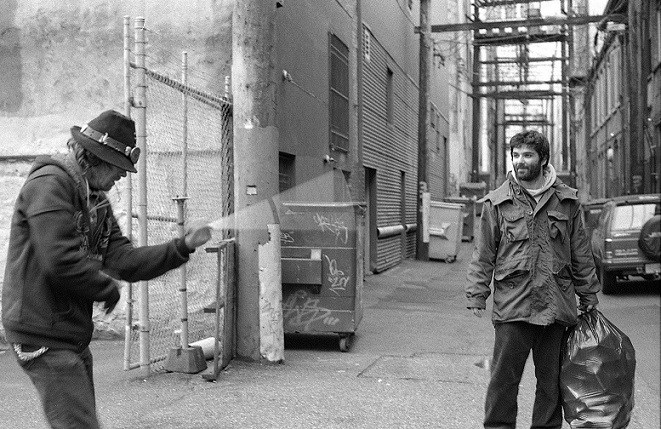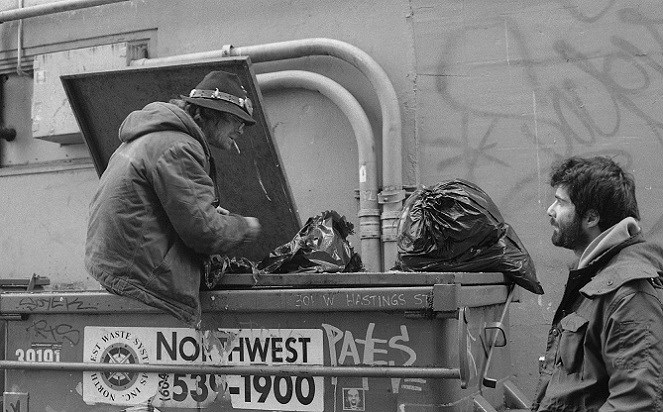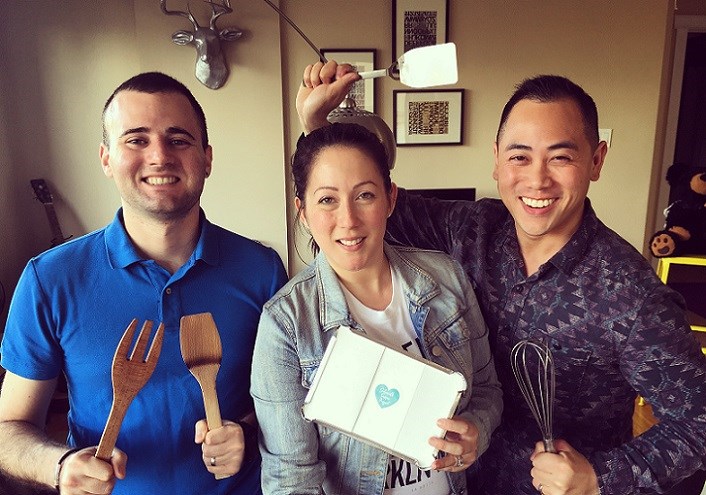The founders of the SIDEWALK supper project share their stories as they connect with people living on the streets. This week, meet a young professional who decided to experience first-hand the struggles of being homeless.
 Nima (right) and Kenneth (left). Photographer: Nicole Ignacio
Nima (right) and Kenneth (left). Photographer: Nicole Ignacio
University graduate. Professional scientist. Violinist. These probably aren’t the words that come to mind as you pass someone sleeping in an alley in the Downtown Eastside.
Meet Nima Farzaneh, a bioinformatician from Vancouver. Like many of us, he never had to struggle to find food or shelter. He was given opportunities in life to pursue an education, a career, and his goals. He had no frame of reference when it came to understanding what it’s like for those whose circumstances lead to life on the streets. So he decided to change that.
For one week during the holiday season, Nima gave up the comfort that he was familiar with to experience the harsh reality of those less fortunate. He packed up a few things and made his way to the Downtown Eastside, where he spent his days meeting the residents of the neighbourhood, struggling to stay warm in alleyways, and writing about every encounter and conversation, which he has now published as a book.
It was cold, wet, bleak—he was looking for education that would challenge his perceptions, but what he didn’t expect to find was hope in an area steeped in despair.
Here is Nima’s story.
----------------------------
EDDY: What inspired you to experience living on the streets?
NIMA: One day while taking the bus to work, I wondered what it would be like to be homeless during Christmas. Throughout my life, I had food and shelter. The idea of struggling for basic needs was completely foreign to me. One thing you should know about me is that when an idea enters my head, I don’t question it. Instead, I set up a plan and turn that thought into reality.
EDDY: Why did you choose to do it at Christmas?
NIMA: Christmas is a time most of us spend with family and friends. Everything is abundant: food, drink, shopping and festivities. To me, it made sense to do the exact opposite to get an appreciation of what it means to have nothing. More importantly, I wanted to write their story and get to know those who live this life every day.
EDDY: What did your friends and family think?
NIMA: The reaction varied wildly. The majority thought it was crazy/dangerous and a few thought it was a good idea. Most have pre-conceived ideas regarding a place like the Downtown Eastside, even if they have never been there before. My family was supportive, but worried for my safety.
EDDY: What was an ordinary day like? What were your sleeping arrangements like?
NIMA: Each day was quite different for me. But one theme stood out day after day: I had excellent discussions and conversations with strangers. We addressed deep and meaningful topics that are often neglected in the general population.
My sleeping arrangements were difficult at times. The cold weather had me waking up shivering one night. I was often tired throughout the day and needed more rest. It’s difficult to catch up on sleep during the day in the back of an alley; the backdoors of shops in alleys can swing open without warning. As the days passed, I was able to adapt and found a few quiet areas to catch up on sleep.
EDDY: What was your scariest moment?
NIMA: I had two scary moments, one on my very first day. A car drove up beside me in the middle of the night while I was sleeping in an alley. He got out of his car and approached me. My heart was pounding. He was trying to offer me food. Clearly, my mind was playing tricks on me.
The other unpleasant experience was when the Vancouver Police Department pulled me over and started questioning me. They told me that the person I was talking to is a dangerous criminal and that I was too naïve to be here. The man he was referring to was Kenneth Trevail. Kenneth and I have been friends for over 6 years now. I guess the cop was wrong.
EDDY: What was your most uncomfortable moment?
NIMA: Initially, sleeping on concrete was something I had to get used to. But after a few days, it was manageable. Also, Vancouver rain can be relentless and walking around with wet clothes without a change of clothes is not comfortable either. Lastly, since I never took off my shoes, the skin on the sole of my foot started to peel and form cracks. I think all of these were equally uncomfortable at a physical level. On a mental level, being ignored by the public and seen as lower beings is taxing as well. I was fortunate to not suffer any physical or mental abuse by anybody while I was there.
 Photographer: Nicole Ignacio
Photographer: Nicole Ignacio
EDDY: What surprised you?
NIMA: What surprised me the most was how kind, intelligent, interesting and talented many of the residents in the Downtown Eastside are. I had a feeling that the media wasn’t doing justice to the area, but I didn’t expect such a large discrepancy.
EDDY: Tell us about some of the people you met.
NIMA: Kenneth Trevail solved a rat infestation problem that was plaguing many businesses, caught burglars breaking into a store and occasionally teaches high school students about life there. I met him while he was homeless. He is now residing in a single room occupancy hotel. He plays six instruments, all of which he taught himself. In his spare time he does art and builds cool sculptures.
Mike draws fascinating paintings on store napkins. His art is extremely detailed and quite amazing considering it’s drawn on a napkin!
Unfortunately, Gilles and John are two characters who were severely mistreated by others. Sometimes good people get taken advantage of. Their stories are classic cases of this.
EDDY: Were there any uplifting moments?
NIMA: Yes, there were many uplifting moments. There were numerous kind gestures made by complete strangers during the holiday season. The whole city feels vibrant and even dark alleys shine light.
EDDY: Did your perceptions on homelessness change? If so, how?
NIMA: Yes, absolutely! For one, I used to have my reservations about that area. I used to lock my car doors as I was driving through Main & Hastings. Now, I do not have this prejudice any longer. I feel a lot more empathetic to their situation and know there is a story.
I learned that you can’t depend on someone else’s point of view to form your own. This means that you should also question my point of view. Find out for yourself! If you listen to the mass media, they will most likely misguide you.
EDDY: Do you have a message for those of us reading?
NIMA: Try to keep an open mind and form your own opinion. I am a scientist, so I like to explore my world and test theories. I hope that you find the time to explore the world you live in as well to form your own conclusions.
------------------------------------
You can read about Nima’s full experience in the Downtown Eastside with his book, A Homeless Christmas, available at local libraries and from Amazon for free. He has no intention of profiting from his work—he simply wants to share his story.
About SIDEWALK supper project: We’re a group of young West Enders bringing the warmth of our kitchen to the streets, feeding the homeless with home-cooked meals and sharing their stories along the way. 100% non-profit. 100% love.
Follow us on Facebook // Instagram // Twitter
 Co-founders Andrea & Eddy (centre & right) with advocate / husband Thomas (left)
Co-founders Andrea & Eddy (centre & right) with advocate / husband Thomas (left)


